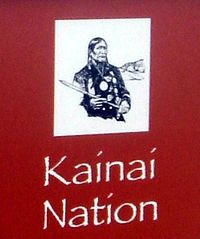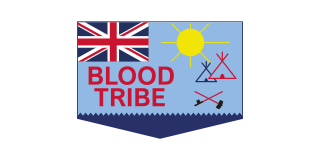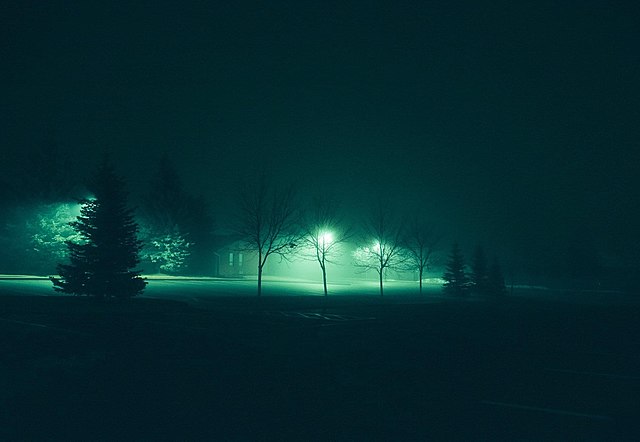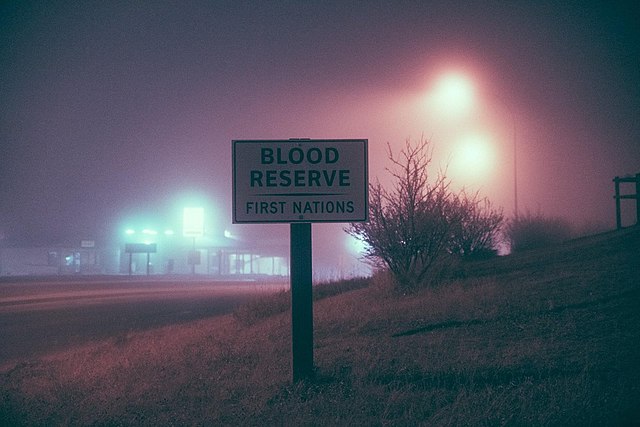Loading AI tools
First Nation in Alberta, Canada From Wikipedia, the free encyclopedia
The Kainai Nation (Blackfoot: ᖿᖱᖻᖳ, romanized: Káínaa or ᖿᖱᖻᖷ, romanized: Káínawa, Blood Tribe) is a First Nations band government in southern Alberta, Canada, with a population of 12,965 members in 2024,[5] up from 11,791 in December 2013.[6]
 Shield of the Kainai Nation | |
| People | Blackfoot |
|---|---|
| Treaty | Treaty 7 |
| Headquarters | Stand Off |
| Province | Alberta |
| Land[1] | |
| Main reserve | Blood 148 |
| Other reserve(s) | |
| Land area | 1362.639 km2 |
| Population (2021)[2] | |
| On reserve | 4,572[3] |
| Total population | 12,963 |
| Government[4] | |
| Chief | Roy Fox |
| Council |
|
| Website | |
| bloodtribe | |



Akáínaa translates directly to 'many chief' (from aká, 'many' and nínaa, 'chief') while Káína translates directly to 'many chief people'. The enemy Plains Cree call the Kainai mihkowiyiniw,[7] 'stained with blood', thus 'the bloodthirsty, cruel', therefore, the common English name for the tribe is the Blood tribe.
The Kainai speak a language of the Blackfoot linguistic group; their dialect is closely related to those of the Siksika and Piikani. They are one of three nations comprising the Blackfoot Confederacy.
At the time treaties such as Treaty 7 were signed, the Kainai were situated on the Oldman, Belly, and St. Mary rivers west of Lethbridge, Alberta. The Kainai reserve Blood 148 is currently the largest in Canada with 4,570 inhabitants[8] on 1,410 km2 (545 sq mi) and is located 200 kilometres (120 mi) south of Calgary.
The Kainai Nation is engaged in diverse enterprises and they trade with domestic and international partners. Ammolite mining for example provides a rare highly demanded gem mineral to Asia for Feng Shui. Ammolite is currently known only to be found in the Bearpaw Formation as unique conditions of prehistoric times were optimal for the fossilization of marine life into ammolite.[9] Over the years, mining operations have uncovered several oceanic dinosaur fossils which have been stored for study at the Royal Tyrrell Museum; however, they belong to the Kainai Nation.(Lawrynuik)[10]
The Kainai Nation filed many specific claims with the federal government. In 2017, a federal court ruled that the Crown had underestimated the band's population, which resulted in the band's reserve being smaller than it should have been. As such, the Blood Tribe reserve could be expanded by 421 square kilometres (163 sq mi), but the community could seek a cash-in-lieu-of-land settlement for this claim instead.[11]
In July 2019, the Kainai Nation settled a claim over Crown mismanagement of the band's ranching assets. The community received a $150 million cash settlement. Chief Roy Fox said that $123 million of this settlement will be used to develop "housing, capital works, a new administration building and a new skating rink".[12]
The Kainai Nation is governed by an elected council of twelve to fifteen, with one chief. The term of office is four years. Historical chiefs of the Kainai are below:
Blood Tribe Councillors (2019)[13]
In pre-treaty times, the iikunuhkahtsi were a society responsible for the punishment of misdeeds. As of 2015[update] the Blood reserve was policed by the Blood Tribe Police, with 31 officers.
In 1960, the Kainai and their Sun Dance were featured in the National Film Board of Canada (NFB) documentary Circle of the Sun. Tribal leaders had been concerned that the Sun Dance might be dying out, and had permitted filming as a visual record.[21][22] This documentary was later referenced by electronic music duo Boards of Canada on their debut album Music Has The Right to Children, with song titles such as "Kanai Industries" and "Pete Standing Alone" paying homage to the tribe and its leader.[23]
In 1973, the NFB released the documentary Kainai, which discusses the construction and consequences of a factory on their property.[24]
In 2006, community leader Rick Tailfeathers contributed a small ammolite carving of a buffalo skull to the Six String Nation project. The object was permanently mounted on the interior of Voyageur, the guitar at the heart of the project.[25] Following a presentation about the project in September 2014 at Tatsikiisaapo'p Middle School, project creator Jowi Taylor was presented with a braid of sweet grass by school principal Ramona Big Head. The braid resides in the headstock area in the bed of the guitar case.
On National Aboriginal Day in 2011, the NFB released the Pete Standing Alone trilogy, which includes Circle of the Sun, Standing Alone and a 2010 film, Round Up, documenting 50 years of the Kainai Nation as well as the life of elder Pete Standing Alone.[26]

The Kainai nation communities include:[30]
Seamless Wikipedia browsing. On steroids.
Every time you click a link to Wikipedia, Wiktionary or Wikiquote in your browser's search results, it will show the modern Wikiwand interface.
Wikiwand extension is a five stars, simple, with minimum permission required to keep your browsing private, safe and transparent.